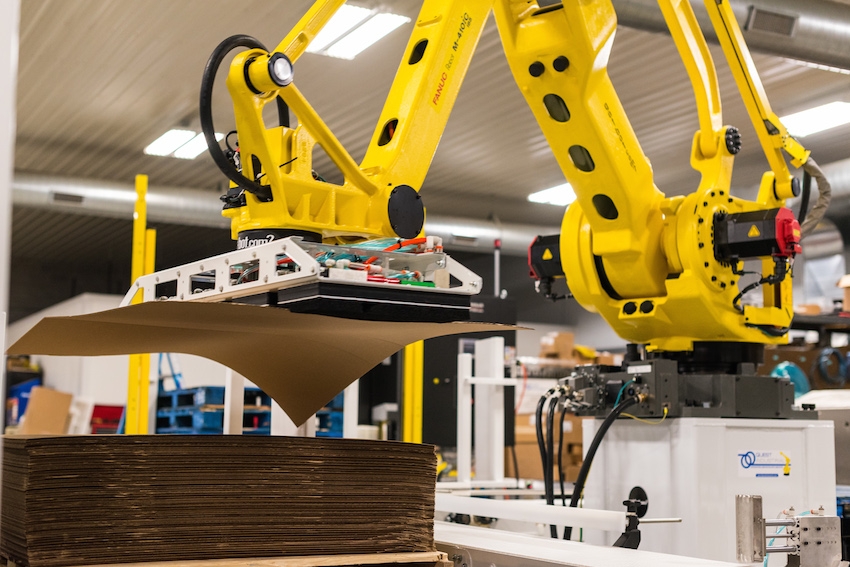
Solving food manufacturing labour shortages with robotics
March 25, 2017
By Maria Ferrante PMMI

Mar. 25, 2017 – A 2015 study by Deloitte and The Manufacturing Institute estimated that two million out of an estimated 3.5 million manufacturing jobs created over the next decade will go unfilled due to a skills gap.
Like many other industries, food manufacturing faces a chronic labour shortage that only promises to get worse as increasing numbers of baby boomers retire. Robotic automation can offer a solution to maintain and enhance productivity, and new advances in collaborative robotics mean more production line personnel will be working side by side robotic counterparts.
We had a chance to speak about new technologies and trends in automation with Don Wickstrum, president and owner of Quest Industrial, a robotics integrator based in Monroe, Wis. Wickstrum will present an Innovation Stage seminar at the inaugural ProFood Tech (April 4-6; McCormick Place, Chicago) on how robotics can fill the labour shortage in the food industry.
• What are some key benefits of robotics automation for food manufacturing?
Finding a reliable workforce is proving to be a difficult task for manufacturers, and robotics offer a convenient way to fill in those gaps along a production line. We see particularly severe labour shortages in certain geographic sectors like the Midwest. Manufacturers are often surprised to learn about how many operations can be handled by robotics. Between 40 to 60 per cent of our business as a robotics integrator is in the food and dairy industry, and our equipment is handling almost everything from frozen foods to raw cheese.
• In what specific areas are robotics playing an increasingly important role?
You see robotics having the greatest fit in roles where workers are subject to back or knee injuries, or from repetitive motion injuries (RMIs) including shoulder, elbow, rotator cuff, wrist and neck injuries. Some good examples are palletizing and case packing; placing boxes of cheese or other mixed bundles on a pallet can be back-breaking work. With the use of automated guided vehicles (AGVs), robotics can eliminate the risk of injuries from operators getting in and out of forklifts, while increasing productivity. If you have a worker palletizing 5-lb bags, the chances are that worker will not last in the job longer than six months. Manufacturers simply cannot keep these jobs filled.
• How have the economics of robotics integration changed in recent years?
I’ve seen a lot of change in the 15 years since I founded our company. Today, around 85 per cent of our customers see a return on their investment in robotics within only two years, which is a clear indication of how robotics integration has become more cost-effective. One employee back injury can end up costing a manufacturer the same amount as a basic robotic palletizer. Customers who are experiencing a labour shortage are at serious risk of a plant shutdown, and they are looking to robotics automation to avoid this possibility.
• What are some emerging trends in robotics that are of interest to food manufacturers?
The technology is changing every day, but in the last few years, the industry has seen major developments in collaborative robotics, in which robots are deployed safely next to humans. Some collaborative robots on the market now can lift 70 lbs and do the work of two or three people. I think in the food industry we will see an increase of 10 to 15 per cent in collaborative robotics, particularly for sealed goods. For raw foods integration is increasing at a slower pace due to sanitation concerns.
• What should food manufacturers look for in a robotics integrator?
It is important for integrators to understand the nuances of the food industry, including sanitation and food safety concerns, wash down procedures, and 3A design standards. Integrating sophisticated vision systems and traceability into automation are becoming more important, so your integrator needs to be familiar with the robotic options on the market. Every food operation is different, and integrators should have a proven track record of strong support and sticking by you to ensure success. My advice to manufacturers is not to narrow your expectations of where robotics can fit into operations. Look at areas where you have chronic labour shortages, and chances are robotics can offer a solution.
—
Wickstrum’s presentation, entitled Filling Your Labor Shortage with Robotic Automation will take place on Wednesday, April 5 at 11:30 a.m.-12:00 p.m., at Innovation Stage Booth #1860. The Innovation Stage at ProFood Tech offers show attendees free, 30-minute seminars throughout the day that cover breakthrough technologies, innovative applications and new techniques. Each presentation offers comfortable, lounge-style seating and a question-and-answer period with industry experts.
Maria Ferrante, senior director, marketing and communications, PMMI. PMMI, The Association for Packaging and Processing Technologies, represents the voice of more than 750 North American manufacturers and suppliers of equipment, components and materials as well as providers of related equipment and services to the packaging and processing industry.
Advertisement
- HMI/SCADA upgrade helps Beauti-Tone Paint maximize production
- Brandt to save shuttered Saskatoon plant